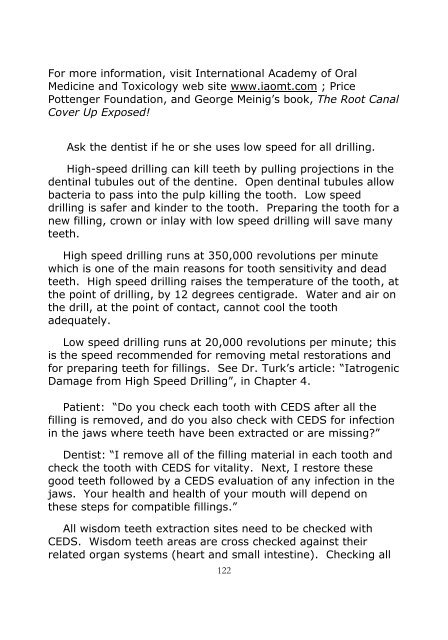Saved by My Dentist - New Solutions to a Health ... - Get a Free Blog
Saved by My Dentist - New Solutions to a Health ... - Get a Free Blog
Saved by My Dentist - New Solutions to a Health ... - Get a Free Blog
You also want an ePaper? Increase the reach of your titles
YUMPU automatically turns print PDFs into web optimized ePapers that Google loves.
For more information, visit International Academy of Oral<br />
Medicine and Toxicology web site www.iaomt.com ; Price<br />
Pottenger Foundation, and George Meinig‟s book, The Root Canal<br />
Cover Up Exposed!<br />
Ask the dentist if he or she uses low speed for all drilling.<br />
High-speed drilling can kill teeth <strong>by</strong> pulling projections in the<br />
dentinal tubules out of the dentine. Open dentinal tubules allow<br />
bacteria <strong>to</strong> pass in<strong>to</strong> the pulp killing the <strong>to</strong>oth. Low speed<br />
drilling is safer and kinder <strong>to</strong> the <strong>to</strong>oth. Preparing the <strong>to</strong>oth for a<br />
new filling, crown or inlay with low speed drilling will save many<br />
teeth.<br />
High speed drilling runs at 350,000 revolutions per minute<br />
which is one of the main reasons for <strong>to</strong>oth sensitivity and dead<br />
teeth. High speed drilling raises the temperature of the <strong>to</strong>oth, at<br />
the point of drilling, <strong>by</strong> 12 degrees centigrade. Water and air on<br />
the drill, at the point of contact, cannot cool the <strong>to</strong>oth<br />
adequately.<br />
Low speed drilling runs at 20,000 revolutions per minute; this<br />
is the speed recommended for removing metal res<strong>to</strong>rations and<br />
for preparing teeth for fillings. See Dr. Turk‟s article: “Iatrogenic<br />
Damage from High Speed Drilling”, in Chapter 4.<br />
Patient: “Do you check each <strong>to</strong>oth with CEDS after all the<br />
filling is removed, and do you also check with CEDS for infection<br />
in the jaws where teeth have been extracted or are missing?”<br />
<strong>Dentist</strong>: “I remove all of the filling material in each <strong>to</strong>oth and<br />
check the <strong>to</strong>oth with CEDS for vitality. Next, I res<strong>to</strong>re these<br />
good teeth followed <strong>by</strong> a CEDS evaluation of any infection in the<br />
jaws. Your health and health of your mouth will depend on<br />
these steps for compatible fillings.”<br />
All wisdom teeth extraction sites need <strong>to</strong> be checked with<br />
CEDS. Wisdom teeth areas are cross checked against their<br />
related organ systems (heart and small intestine). Checking all<br />
122


